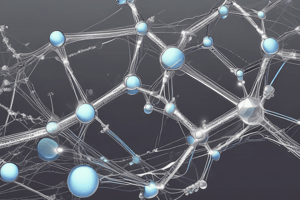Podcast
Questions and Answers
What does the movement of molecules reflect?
What does the movement of molecules reflect?
Kinetic energy of molecules.
What happens to the speed of molecular movement with temperature?
What happens to the speed of molecular movement with temperature?
- It is independent of molecular size
- It decreases in larger molecules (correct)
- It remains constant regardless of temperature
- It increases with increasing temperature (correct)
What term describes a hypertonic solution?
What term describes a hypertonic solution?
Crenated.
What is an isotonic solution?
What is an isotonic solution?
Describe a hypotonic solution.
Describe a hypotonic solution.
What determines whether a transport process is active or passive?
What determines whether a transport process is active or passive?
Which of the following are passive processes? (Select all that apply)
Which of the following are passive processes? (Select all that apply)
Which processes are considered active?
Which processes are considered active?
Name one similarity between simple diffusion and osmosis.
Name one similarity between simple diffusion and osmosis.
Name one difference between simple diffusion and osmosis.
Name one difference between simple diffusion and osmosis.
What is one similarity and one difference between simple diffusion and facilitated diffusion?
What is one similarity and one difference between simple diffusion and facilitated diffusion?
Why is it better to use an isotonic sports drink than plain water for extracting DNA from cheek cells?
Why is it better to use an isotonic sports drink than plain water for extracting DNA from cheek cells?
What dye diffused more rapidly?
What dye diffused more rapidly?
Why did the dye molecule move slowly?
Why did the dye molecule move slowly?
What is the relationship between molecular weight and the rate of molecular movement?
What is the relationship between molecular weight and the rate of molecular movement?
Look at notes in notebook.
Look at notes in notebook.
Flashcards
Molecular Movement and Kinetic Energy
Molecular Movement and Kinetic Energy
The movement of molecules reflects the kinetic energy they possess. Higher kinetic energy means faster movement.
Temperature and Molecular Speed
Temperature and Molecular Speed
As temperature increases, molecules move faster. Conversely, as temperature decreases, molecules slow down.
Hypertonic Solution
Hypertonic Solution
A hypertonic solution has a higher concentration of solutes compared to the cell's internal environment. This causes water to move out of the cell, leading to cell shrinkage.
Isotonic Solution
Isotonic Solution
Signup and view all the flashcards
Hypotonic Solution
Hypotonic Solution
Signup and view all the flashcards
Active Transport
Active Transport
Signup and view all the flashcards
Passive Transport
Passive Transport
Signup and view all the flashcards
Osmosis
Osmosis
Signup and view all the flashcards
Phagocytosis
Phagocytosis
Signup and view all the flashcards
Simple Diffusion and Osmosis: Similarity
Simple Diffusion and Osmosis: Similarity
Signup and view all the flashcards
Simple Diffusion and Osmosis: Difference
Simple Diffusion and Osmosis: Difference
Signup and view all the flashcards
Simple Diffusion and Facilitated Diffusion: Similarity
Simple Diffusion and Facilitated Diffusion: Similarity
Signup and view all the flashcards
Simple Diffusion and Facilitated Diffusion: Difference
Simple Diffusion and Facilitated Diffusion: Difference
Signup and view all the flashcards
Isotonic Sports Drinks for DNA Extraction
Isotonic Sports Drinks for DNA Extraction
Signup and view all the flashcards
Methylene Blue: Rapid Diffusion
Methylene Blue: Rapid Diffusion
Signup and view all the flashcards
Dye Movement and Molecular Weight
Dye Movement and Molecular Weight
Signup and view all the flashcards
Molecular Weight and Movement Rate
Molecular Weight and Movement Rate
Signup and view all the flashcards
Study Notes
Molecular Movement
- Molecular movement indicates the kinetic energy of the molecules.
- Larger molecules exhibit lower speed of molecular movement, while increased temperature boosts molecular speed.
Solutions and Cellular Responses
- Hypertonic solutions lead to crenation of cells.
- Hypotonic solutions cause hemolysis, leading to cell bursting due to excessive water influx.
- Isotonic solutions maintain equilibrium, preventing cell damage.
Transport Mechanisms
- Transport processes are classified as active or passive based on energy expenditure; active processes require ATP.
- Passive processes include simple diffusion, facilitated diffusion, and osmosis, using hydrostatic pressure or molecular energy as driving forces.
- Active processes such as phagocytosis and pinocytosis occur against concentration or electrical gradients.
Diffusion Comparisons
- Similarities: Both simple diffusion and osmosis involve movement from areas of high concentration to low concentration.
- Differences: Osmosis specifically pertains to water movement across a selectively permeable membrane, while simple diffusion applies to all molecule types.
Facilitated vs. Simple Diffusion
- Similarities: Both follow the concentration gradient and utilize kinetic energy for movement.
- Differences: Simple diffusion does not require carrier proteins, while facilitated diffusion does; facilitated diffusion typically involves larger molecules compared to the smaller molecules in simple diffusion.
Practical Applications
- Using an isotonic sports drink for DNA extraction from cheek cells is advantageous as it contains salts and concentrations compatible with the cells, reducing potential damage.
- Methylene blue dye diffuses more rapidly than other dyes due to its molecular properties.
- Molecular weight inversely affects the rate of molecular movement; heavier molecules move slower compared to lighter ones.
Studying That Suits You
Use AI to generate personalized quizzes and flashcards to suit your learning preferences.




